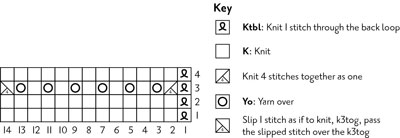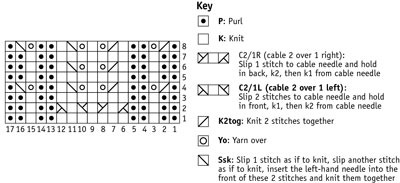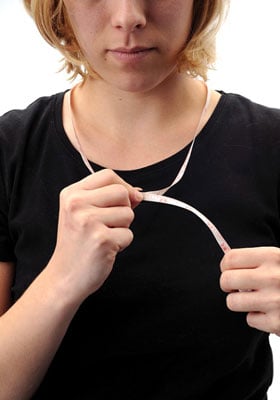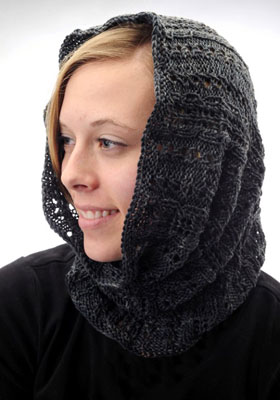Book of 60 Easy Knit and Crochet Cowls
This simple project, presented here as a master pattern, is the perfect starting bespeak for knitting in the circular. Choose the desired circumference of your cowl, make a gauge swatch to determine your bandage-on number, and away you go!
You can knit this cowl in plain stockinette stitch and permit it to curl at the edges, or add together a elementary border of garter sew together to command the natural roll of stockinette run up. You tin can likewise knit it in a diversity of stitch patterns; information technology lends itself well to lacy, open designs.

-
Size: XS (S, M, 50, XL)
-
Circumference: 20 (26, 32, 44, l) inches
This cowl is circular in shape. You can arrive whatever circumference and tiptop y'all want. The circumference is determined by the number of stitches you cast on; the height is adamant by how many rounds you knit before y'all bind off. The L and XL sizes are intended to be wrapped twice around your neck.
-
Needles: One sixteen-inch (or longer) circular needle in the size needed to go your desired gauge.
-
Notions:
Stitch markers
Seaming needle
-
Yarn: Y'all tin can employ virtually any weight of yarn for this project. The number of yards you need will vary, depending on gauge, sew pattern, and the size of the cowl. The table gives you a rough estimate of the yardage for a 20–50" cowl that is approximately 12" tall.
Gauge in stockinette Approximate yardage 3 sts/inch 120–450 yards iv sts/inch 160–500 yards v sts/inch 200–650 yards half dozen sts/inch 260–800 yards vii sts/inch 325–950 yards 
If you plan to utilize this stitch patterm on your cowl, be sure to cast on a number of stitches that is a multiple of xiv.

If y'all program to utilize this stitch pattern on your cowl, be certain to bandage on a number of stitches that is a multiple of 17.
It is best to piece of work this projection using one circular needle in the traditional method. Yous can piece of work smaller cowls on a xvi-inch round; larger cowls will fit meliorate on a 32-inch round. However, if yous do non have the correct length of circular needle to fit all of your cast-on stitches, you tin use 2 circulars or the magic loop method.
Drape a tape measure or a 50-inch piece of cord around your neck and arrange it to find your desired cowl circumference.

This master pattern offers sizes ranging from twenty inches all the mode up to fifty inches. The smaller cowls volition fit in one case effectually your neck, and, if y'all knit it to a sufficient height, you tin can pull it up over the head as a snood.

The 32-inch cowl tin can drape gracefully around the neck equally both a style accessory and a buffer confronting the cold winter winds. The ii largest sizes are large enough that you can wrap them twice around the neck for added warmth, or once around the neck as a dramatic accent.
When choosing yarn for your cowl, consider the purpose you want your finished project to fulfill. If you lot are seeking a year-circular accessory, choose a yarn that reflects that; cotton, rayon, or silk would be comfy only about anywhere. If you desire a cowl item that'due south suited for absurd-weather habiliment, attempt wool or some other animate being fiber. Recollect about color as well; a unproblematic stockinette cowl will bear witness the colors of a variegated or cocky-patterning yarn to best advantage, while a solid or semi-solid colour yarn is more appropriate for a complicated sew together pattern.
After choosing your yarn, consider a stitch pattern. You can work this cowl in stockinette sew together, one of the lacy patterns presented in Cowl B or C, a run up blueprint, or a pattern of your own. One time you've chosen a stitch pattern, make a swatch in that pattern to determine your judge and your needle size. Your gauge will make up one's mind the number of stitches you lot cast on to reach a given size. Bear in heed that your total number of bandage-on stitches should exist divisible past the number of stitches in your sew pattern. For example, if your sew together blueprint is 12 stitches wide, circular the cast-on number from the table on the adjacent page to a multiple of 12.
-
Using the long-tail cast-on, cast on the number of stitches specified in the tabular array for your judge and desired cowl size.
Gauge Number of Stitches to Cast On 3 sts/inch 60 (78, 96, 132, 150) four sts/inch 80 (104, 128, 176, 200) five sts/inch 100 (130, 160, 220, 250) 6 sts/inch 120 (156, 192, 264, 300) 7 sts/inch 140 (182, 224, 308, 350) -
Accommodate your stitches on the needle and join for working in the round, existence careful non to twist the cast-on around the needles. Place a marker to betoken the stop of the round.
-
If you desire an edging, work a few rounds of garter sew as follows: *Knit 1 circular; purl ane round. Repeat from * once.
-
Begin to work in stockinette or your chosen stitch design until the cowl measures the desired top from the bandage-on edge.
Try 12–24 inches for a single-wrap cowl and viii–12 inches for a longer cowl. The cowl should be at least xviii inches alpine if you desire to wear it as a snood.
-
If you lot want an edging, work a few rounds of garter stitch every bit follows: *Knit one round; purl i round. Echo from * once.
-
Bind off loosely. Weave in yarn ends.
-
Launder and block, if desired.
If you chose a lace pattern, it is especially of import to block your finished item to open upward the lace.
About This Commodity
This commodity can be found in the category:
- Knitting & Crocheting ,
Source: https://www.dummies.com/article/home-auto-hobbies/crafts/knitting-crocheting/how-to-knit-a-cowl-170728/
0 Response to "Book of 60 Easy Knit and Crochet Cowls"
Post a Comment